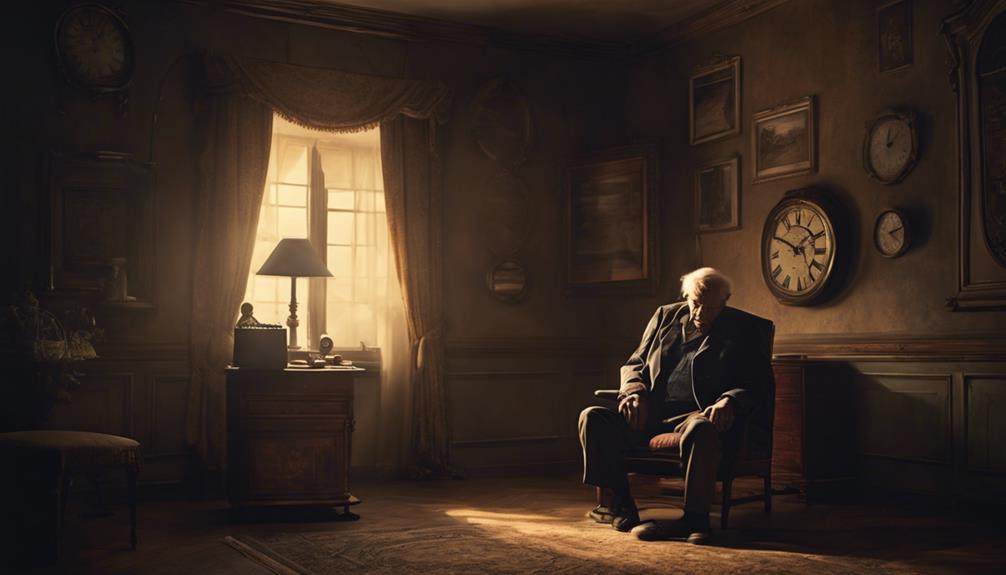Causes of Sundowners Syndrome include disturbances in circadian rhythms, sensory deprivation, unmet needs, and low lighting. These factors impact the severity of symptoms for individuals with this condition. Sundowning is exacerbated by fatigue, resulting in increased confusion and agitation. Loud noises can trigger or worsen episodes, so it is important to carefully manage noise levels. Environmental elements such as lighting and noise are significant factors. Exposure to outdoor sunlight can assist in regulating your internal clock and enhancing mood. Rest is crucial for managing sundowning by regulating rhythms and preventing fatigue. By following these tips, you can better understand and handle Sundowners Syndrome.
Key Takeaways
- Disruptions in circadian rhythms can trigger Sundowners Syndrome.
- Sensory deprivation plays a role in the onset of Sundowners Syndrome.
- Unmet needs, such as hunger or thirst, can worsen Sundowners Syndrome.
- Low lighting environments contribute to the development of Sundowners Syndrome.
- Noise sensitivity and exposure to loud noises can trigger Sundowners Syndrome episodes.
Common Triggers of Sundowning
Common triggers of sundowning include disruptions in circadian rhythms, which can result in confusion and agitation among individuals with dementia. Our bodies have internal clocks that regulate sleep-wake cycles, and when these rhythms are disturbed, it can lead to increased restlessness and irritability during the evening hours.
In addition to circadian rhythms, factors like sensory deprivation, unmet needs, and low lighting can also contribute to the escalation of sundowning symptoms. Sensory deprivation, such as limited exposure to different stimuli throughout the day, can heighten feelings of disorientation and anxiety in individuals experiencing sundowning.
Additionally, unmet physical or emotional needs can manifest as agitation and distress, intensifying the challenges faced by those with dementia. Additionally, insufficient lighting can further disrupt sleep patterns and exacerbate insomnia, creating a cycle of fatigue and restlessness that can worsen sundowning behaviors.
Impact of Fatigue on Sundowners

Disruptions in circadian rhythms, such as those caused by fatigue, can greatly worsen sundowning symptoms in individuals with dementia. When fatigue sets in due to lack of rest, it can lead to increased agitation, confusion, and irritability during the late afternoon and evening, precisely when sundowning symptoms tend to peak.
It's vital to understand that fatigue may exacerbate behaviors like pacing, wandering, and aggression in those experiencing sundowners syndrome. Addressing and managing fatigue through proper rest and sleep hygiene is key in minimizing the impact of sundowning.
Role of Loud Noises in Sundowning
Loud noises play a significant role in triggering or exacerbating sundowning episodes in individuals with dementia. For people with dementia, sudden or continuous loud noises can cause feelings of agitation, confusion, and distress during sundowning. Noise sensitivity is common among these individuals, making them more prone to being affected by loud sounds, which can impact their behavior negatively.
Hence, managing noise levels in the environment is vital to prevent symptoms of sundowning from escalating. Creating a quiet and calm atmosphere by reducing loud noises can help minimize the triggers for sundowning episodes. By maintaining a peaceful environment with minimal noise disturbances, caregivers can help improve the well-being of individuals with dementia during the evening hours.
Environmental Changes and Sundowning

When it comes to sundowning, changes in the environment play an essential role. Low lighting can make symptoms worse, while noise levels can also impact the onset of sundowning behaviors.
It's important to be mindful of these environmental factors to help manage sundowning episodes effectively.
Lighting Impacts Sundowning
In the evening, the impact of lighting on sundowning symptoms in individuals with dementia is significant. Low lighting can worsen late-day confusion and agitation. Environmental lighting changes can disrupt circadian rhythms, leading to increased restlessness.
To help minimize the effects of sundowning, maintaining a well-lit environment in the late afternoon and evening is vital. Bright light exposure during these times can positively influence mood and behavior, potentially reducing sundowning symptoms.
Adequate lighting plays a key role in creating a calming atmosphere and promoting a sense of security for those experiencing sundowning. Hence, ensuring a well-lit environment during the evening hours can greatly benefit individuals with dementia by providing them with a more comfortable and soothing setting.
Noise Affects Sundowning
Establishing a peaceful environment with minimized noise levels is essential for managing and potentially preventing the worsening of sundowning symptoms in individuals with dementia. Excessive noise, especially in the late afternoon and evening, can exacerbate symptoms of sundowning. Loud noises can increase confusion, anxiety, agitation, and irritability in those experiencing sundowning.
Environmental changes, including noise levels, have a substantial impact on behavior and mood during sundowning episodes. To help manage sundowning symptoms effectively, it's vital to create a quiet and calm environment by reducing noise. Minimizing disruptive sounds and stimuli in the surroundings is pivotal for providing a soothing atmosphere for individuals experiencing late-day confusion.
Managing Sundowning With Routine Activities

To effectively manage sundowning, it's important to establish a structured daily routine that includes engaging activities, consistent meal times, and a regular sleep schedule. These routine activities can help provide comfort, stability, and a sense of security for individuals experiencing sundowning.
Daily Structured Routine
Creating a daily structured routine plays an essential role in effectively managing sundowning by providing stability and predictability for individuals with dementia. Consistency in daily activities helps regulate sleep-wake cycles, reducing anxiety and agitation during late afternoon behaviors. Here are three key points to ponder for establishing a structured routine:
- Schedule regular meals, exercise, and leisure activities to maintain a predictable daily routine.
- Guarantee consistent timing for tasks like bathing, grooming, and medication administration to enhance feelings of security.
- Engage in familiar activities at specific times each day to create a sense of purpose and accomplishment, decreasing restlessness.
Meaningful Engagement Activities
Engaging in routine activities during the late afternoon and evening can significantly assist in managing sundowning symptoms by providing structure and familiarity. Meaningful engagement activities like folding laundry, looking at old photos, or listening to calming music can help reduce anxiety, restlessness, and confusion in individuals experiencing sundowning.
Consistent engagement in activities during these times can create a sense of security and comfort. Tailoring activities to the individual's preferences and capabilities is crucial for effective management of sundowning behaviors.
Consistent Sleep Schedule
As we focus on managing sundowning through routine activities, establishing and maintaining a consistent sleep schedule is fundamental for minimizing late-day confusion in individuals with dementia.
Consistency in sleep patterns plays an important role in regulating the body's internal clock, which can help reduce sundowning symptoms and promote a sense of security.
Bedtime rituals and calming activities before sleep aid in easing the shift into nighttime, decreasing agitation, and improving overall sleep quality.
By adhering to a structured bedtime routine, individuals prone to sundowning can experience enhanced well-being, cognitive function, and mood stability.
Prioritizing a regular sleep and wake schedule is vital to support those experiencing sundowning symptoms effectively.
Benefits of Outdoor Sunlight Exposure

Outdoor sunlight exposure plays an important role in regulating our internal clock and can greatly benefit individuals experiencing sundowners syndrome. Sunlight exposure helps in managing the circadian rhythm, which is vital for maintaining a healthy sleep-wake cycle. For those with sundowners syndrome, being outdoors in natural light can aid in reducing restlessness and agitation during late afternoon and evening hours. Additionally, sunlight exposure stimulates the production of vitamin D, which can enhance mood and cognitive function, potentially alleviating some symptoms of sundowners syndrome. Moreover, regular exposure to sunlight supports overall well-being by promoting a sense of routine and structure, which may decrease confusion and anxiety commonly associated with sundowning.
| Benefits of Outdoor Sunlight Exposure | ||
|---|---|---|
| Regulates internal clock | Reduces restlessness and agitation | Boosts vitamin D production |
| Improves circadian rhythm | Enhances mood and cognitive function | Supports overall well-being |
Importance of Rest for Sundowning

Exposure to natural light during the day can positively impact an individual's rest patterns, which are essential for managing sundowning symptoms. Adequate rest plays a pivotal role in managing sundowning symptoms by reducing fatigue and irritability. Here are three key points highlighting the importance of rest for individuals experiencing sundowning:
- Regulating Circadian Rhythms: Establishing a consistent sleep schedule can help regulate circadian rhythms, which are vital for maintaining a healthy sleep-wake cycle. This can lead to improved overall sleep quality and reduced sundowning symptoms.
- Preventing Fatigue: Restful periods during the day can prevent excessive tiredness, which is a common trigger for sundowning episodes. Ensuring the individual gets sufficient rest at night can contribute to a calmer and more stable evening routine, reducing the likelihood of sundowning.
- Enhancing Sleep Quality: A good night's rest can significantly impact an individual's well-being. Quality sleep not only aids in reducing fatigue but also promotes better cognitive function and emotional regulation, which are essential for managing sundowning symptoms effectively.
Limiting Stimulation in Late Afternoon

To minimize the likelihood of triggering sundowning symptoms in individuals with dementia, it is essential to limit stimulation in the late afternoon. Overstimulation, such as loud noises, bright lights, or crowded spaces, can exacerbate agitation and confusion during sundowning episodes. By creating a calm and quiet environment, we can help reduce the chances of these triggers causing distress. Implementing a structured routine with calming activities can aid in the smooth shift into the evening, minimizing the occurrence of sundowning. Avoiding excessive activity or mental stimulation in the late afternoon and evening contributes to a more peaceful and relaxed environment for those experiencing sundowning symptoms.
| Ways to Limit Stimulation | Benefits |
|---|---|
| Reduce noise levels | Calms the environment |
| Minimize distractions | Helps in managing confusion |
| Avoid crowded spaces | Reduces agitation |
Creating a Comfortable Evening Environment

Creating a comfortable evening environment for individuals with sundowners syndrome involves ensuring the space is well-lit to reduce confusion and anxiety. Night lights strategically placed can provide a sense of security and prevent disorientation during the evening hours.
Minimizing clutter and noise in the living space creates a calming atmosphere that promotes relaxation. Playing soothing music or engaging in quiet activities can help individuals with sundowners syndrome unwind before bedtime. Implementing a consistent bedtime routine signals the shift to nighttime and promotes better sleep patterns for those experiencing sundowning behaviors.
Frequently Asked Questions
What Makes Sundowning Worse?
When sundowning worsens, factors like lack of sleep, changes in lighting, physical discomfort, unmet needs, emotional stress, disrupted routines, noise, and overstimulation play a role. We must address these triggers to improve outcomes for individuals with dementia.
How Do You Calm Down Sundowning?
To calm down sundowning, we engage in calming activities like soothing music, gentle massage, and aromatherapy. We create a quiet environment by reducing noise and dimming lights. Encourage relaxation techniques and maintain a consistent routine for stability.
What Stage of Dementia Is Sundowning?
In the middle to late stages of dementia, sundowning can occur. This phase is more common in individuals with Alzheimer's disease. Understanding the stage of dementia helps predict and manage sundowning episodes effectively. Sundowning often involves increased confusion, agitation, and restlessness during the late afternoon or evening hours. Managing sundown syndrome in dementia requires a combination of strategies, such as maintaining a regular daily routine, minimizing sensory overload, and ensuring appropriate lighting to reduce confusion. Caregivers can also provide reassurance and calm activities to help alleviate distress during this time.
What Is the First Line Treatment for Sundowning?
We focus on creating a calming routine, increasing light exposure during the day, and limiting caffeine intake to manage sundowning. Structured activities in the evening help reduce symptoms. Our goal is to provide comfort and support.
Conclusion
To sum up, by acknowledging common triggers such as fatigue, loud noises, and environmental changes, we can better manage sundowners syndrome.
Establishing routine activities, getting outdoor sunlight exposure, and creating a cozy evening environment can help minimize symptoms.
Keep in mind, rest is essential, and limiting stimulation in the late afternoon can make a significant difference.
By taking these steps, we can enhance the quality of life for those experiencing sundowning.









